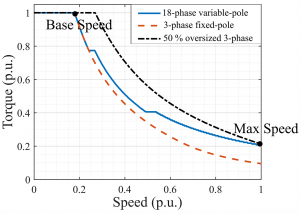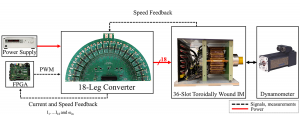Variable-Pole Induction Machines for Electric Vehicles
PhD student Elie Libbos with advisor A. Banerjee
High power density, high efficiency, and inexpensive drivetrain operating over a wide speed range are critical for future electric vehicles (EV). The induction machine (IM) offers a cost-effective and reliable alternative to permanent magnet-based solutions. A multi-leg drive (more than three phases) can reconfigure the machine to various pole counts to extend its speed range and opens a new design space for EV applications. Our proposed 18-leg drive can meet the torque requirement at base and maximum speed with 50% less rating compared to a conventional drive, as shown in Fig. 1.The proposed variable-pole IM system improves efficiency and power density.

Fig. 1. Comparison of torque-speed characteristic of 18-lrg/variable-pole and 3-leg/fixed-pole. The same IM has higher torque capability at maximum speed when the 18-leg drive is used to vary the IM pole count.
Figure 2-a shows our experimental setup. An 18-leg GaN-based inverter is used to drive a 36-slot toroidally wound IM with access to each of its individual slots. This setup allows us to reconfigure the IM to various pole counts (2-, 4-, 6-poles). A Zedboard FPGA is used to control the converter and create a user-friendly interface. Figure 2-b shows our experimental loss reduction achieved by using our proposed 18-leg drive compared to a conventional 3-leg drive. Loss reduction is most significant at partial load, where an EV drivetrain operates for a predominant period of any drive cycle.

